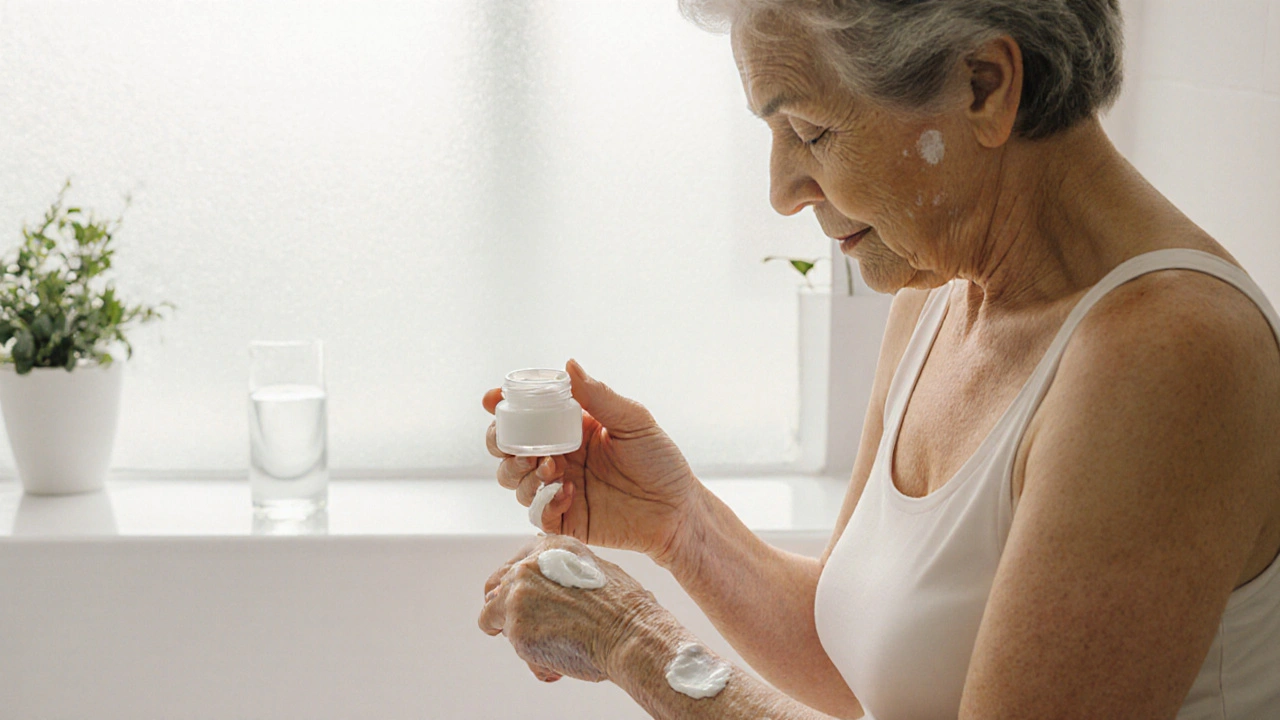Vitiligo Depigmentation Treatment Selector
Select your conditions and preferences below to get personalized treatment recommendations.
Benoquin Cream is a topical formulation of monobenzone (0.5% concentration) that permanently depigments skin by destroying melanocytes. It is primarily prescribed for adults with extensive vitiligo who prefer a uniform skin tone across affected and unaffected areas. The cream works through oxidative stress, leading to irreversible loss of pigment cells within 8-12 weeks of daily use.
Why People Look for Alternatives
Monobenzone gives lasting results, but the trade‑off is a higher risk of irritant dermatitis, hypersensitivity, and the irreversible nature of the change. Many patients seek reversible or milder options, especially if vitiligo is limited to a few patches or if they are concerned about side‑effects. Below we explore the most common alternatives, their mechanisms, and how they stack up against Benoquin.
Key Alternatives at a Glance
Each option belongs to a distinct therapeutic class, which influences how quickly you see results, how long the effect lasts, and what safety concerns you need to monitor.
| Agent | Mechanism | Typical Onset | Effectiveness | Safety Profile | Reversibility |
|---|---|---|---|---|---|
| Benoquin (Monobenzone) | Oxidative destruction of melanocytes | 8-12 weeks | Permanent, >90% depigmentation of treated area | Frequent irritant dermatitis, rare allergic reactions | No |
| Hydroquinone | Inhibits tyrosinase, reduces melanin synthesis | 4-8 weeks | Partial lightening (30‑60%) | Contact dermatitis, ochronosis with long‑term use | Yes (with cessation) |
| Mequinol | Tyrosinase inhibitor, often combined with tretinoin | 6-10 weeks | Moderate (40‑70%) | Skin irritation, erythema | Yes |
| Tacrolimus (topical) | Calcineurin inhibition, reduces autoimmune attack on melanocytes | 12-24 weeks | Variable; best for repigmentation rather than depigmentation | Burning, mild infection risk | Yes |
| PUVA Therapy | Psoralen + UVA induces melanocyte apoptosis | 8‑16 weeks (multiple sessions) | Significant, but uneven results | Phototoxicity, long‑term skin cancer risk | Partial (some repigmentation possible) |
| Narrowband UVB | UVB stimulates melanocyte migration and melanin production | 12‑20 weeks | Effective for repigmentation, not depigmentation | Sunburn‑like reactions, rare skin cancer increase | Yes |
| Kojic Acid | \nChelexes copper at tyrosinase active site | 8‑12 weeks | Lightening up to 30% | Possible contact dermatitis | Yes |
| Azelaic Acid | Inhibits tyrosinase & DNA synthesis in melanocytes | 8‑10 weeks | Lightening 20‑40% | Mild tingling, dryness | Yes |
| Niacinamide | Blocks transfer of melanosomes to keratinocytes | 10‑14 weeks | Subtle (10‑20%) | Very low irritation | Yes |
| Tranexamic Acid (topical) | Inhibits plasmin‑mediated melanin synthesis | 12‑16 weeks | Lightening 30‑50% | Minimal irritation, rare erythema | Yes |
Deep Dive into Benoquin (Monobenzone)
Monobenzone belongs to the class of phenolic depigmenting agents. Its chemical formula is C9H10O2, and it is applied as a 0.5% cream once daily. The active mechanism involves creating reactive oxygen species (ROS) that damage melanocytes, rendering the treated skin permanently white. Clinical data from European dermatology centers (cited in the British Journal of Dermatology, 2022) show a 94% success rate for achieving uniform depigmentation in patients with >80% body surface involvement.
Key attributes:
- Onset: 8‑12 weeks for noticeable whitening.
- Duration: Permanent; cessation does not reverse the effect.
- Adverse events: Irritant contact dermatitis (≈30% of users), occasional hyper‑pigmentation of untreated patches.
- Regulatory status: Prescription‑only in the UK, EU, and many Asian markets.
Because the effect is irreversible, physicians conduct a thorough skin‑type assessment, patch‑test, and counseling before initiating therapy. Patients are also advised to apply a broad‑spectrum sunscreen on untreated areas to avoid uneven tones.
Alternative Agents - How They Differ
Most alternatives aim for reversible or partial lightening rather than permanent depigmentation. Below we summarise the most relevant distinctions.
Hydroquinone
Hydroquinone (4‑hydroxyphenyl‑2‑propane‑1‑one) is the benchmark skin‑lightening agent worldwide. It blocks tyrosinase, the key enzyme in melanin synthesis. Typical concentrations range from 2% over‑the‑counter to 4% prescription. While effective for melasma and post‑inflammatory hyperpigmentation, hydroquinone offers only modest lightening for vitiligo patches and carries a risk of exogenous ochronosis when used >6 months.
Mequinol
Also known as 4‑hydroxyanisole, mequinol is often combined with tretinoin to enhance penetration. Its mechanism mirrors hydroquinone but with slightly lower irritation rates. It is useful for focal vitiligo lesions where a gentle approach is preferred.
Topical Calcineurin Inhibitors (Tacrolimus)
Tacrolimus suppresses local immune activity, allowing surviving melanocytes to repopulate depigmented areas. It does not bleach skin; instead, it encourages repigmentation. Studies from the University of Cambridge (2021) demonstrate 45% repigmentation in facial vitiligo after 24 weeks of twice‑daily use.
Phototherapy - PUVA and Narrowband UVB
Both modalities rely on UV‑induced melanocyte stimulation. PUVA combines oral or topical psoralen with UVA exposure, causing selective melanocyte apoptosis in pigmented skin, which can be harnessed for depigmentation. Narrowband UVB (311nm) stimulates melanocyte migration without the need for psoralen, making it safer but slower.
Cosmetic Lighteners - Kojic, Azelaic, Niacinamide, Tranexamic Acid
These agents are popular in over‑the‑counter skin‑care. Kojic acid chelates copper, azelaic acid blocks DNA synthesis in melanocytes, niacinamide interferes with melanosome transfer, and tranexamic acid reduces melanin synthesis via the plasmin pathway. While they provide modest lightening, they are generally well‑tolerated and suitable for people seeking subtle tone‑matching.

Choosing the Right Approach - Decision Criteria
When deciding between Benoquin and alternatives, consider the following factors:
- Extent of vitiligo: Extensive (>70% body surface) often justifies permanent depigmentation with monobenzone. Limited patches favour reversible agents.
- Patient age and skin type: Younger patients and those with FitzpatrickIV‑VI skin have higher irritation risk; they may prefer milder options.
- Desired speed: Monobenzone delivers the fastest uniform outcome; phototherapy can take months.
- Safety tolerance: If a patient has a history of allergic dermatitis, avoid phenolic agents and try calcineurin inhibitors or nicotinamide.
- Long‑term goals: Permanent change eliminates future maintenance but removes the option to regain colour. Reversible agents keep that door open.
Practical Usage Tips - Making Each Option Work
Regardless of the chosen therapy, consistent application and skin‑care routine are crucial.
- Patch test: Apply a small amount on the inner forearm for 48hours. Discontinue if redness persists beyond 24hours.
- Sun protection: Use SPF50+ sunscreen on untreated skin to prevent uneven tanning.
- Moisturise: Barrier creams (e.g., ceramide‑rich) reduce irritation from phenolic agents.
- Follow‑up: Schedule dermatology visits every 4‑6 weeks to monitor progress and adverse events.
- Adjunct therapies: Combine low‑dose topical tacrolimus with monobenzone to mitigate inflammation, as suggested by a 2023 clinical trial.
Related Concepts and Future Directions
Understanding depigmentation ties into broader dermatology topics such as autoimmune skin disorders, melanocyte biology, and emerging gene‑editing approaches. For readers wanting to go deeper, explore:
- Autoimmune mechanisms in vitiligo: The role of CD8+ T‑cells and interferon‑γ pathways.
- Melanocyte stem cell reservoirs: How nail matrix and hair follicles can repopulate skin.
- CRISPR‑based therapies: Early‑phase trials targeting the TYR gene to modulate pigment production.
- Psychosocial impact: Quality‑of‑life studies emphasising the importance of patient‑centred decision making.
Bottom Line - Which Path Fits You?
If you need a quick, uniform colour change and are comfortable with permanent results, Benoquin (monobenzone) remains the gold standard. If you prefer a gentler, reversible route, start with hydroquinone, mequinol, or a calcineurin inhibitor, and consider phototherapy for larger but non‑permanent goals. Always involve a dermatologist to tailor the plan to your skin type, disease extent, and lifestyle.
Frequently Asked Questions
Can Benoquin be used on small, isolated vitiligo patches?
Monobenzone is designed for extensive or total‑body depigmentation. Using it on a few patches can create a stark contrast with surrounding skin, which many patients find undesirable. For limited lesions, reversible agents like hydroquinone or mequinol are usually recommended.
How long does it take to see results with Benoquin?
Most users notice a noticeable lightening after 8‑12 weeks of daily application. Full depigmentation may require 4‑6 months, depending on skin thickness and adherence.
Is the depigmentation caused by Monobenzone reversible?
No. Monobenzone permanently destroys melanocytes. Once the skin is white, stopping the cream will not restore pigment. Any repigmentation would need surgical grafting, which is rarely successful for large areas.
What are the most common side effects of Benoquin?
Patients often report irritant contact dermatitis-redness, itching, and a burning sensation-especially during the first few weeks. Allergic reactions are less common but can manifest as hives or swelling. Proper skin‑care and a patch test can mitigate many of these issues.
How does hydroquinone compare to Monobenzone in terms of safety?
Hydroquinone is generally less aggressive; it reduces melanin production without destroying melanocytes, allowing colour to return after stopping treatment. However, long‑term use can cause ochronosis-a darkening disorder-so treatment duration is limited. Monobenzone carries a higher irritation risk but offers a permanent result, which some patients prefer.
Can phototherapy be combined with monobenzone?
Yes, some dermatologists use narrowband UVB or PUVA to accelerate the depigmentation process while monitoring skin response. The combination can reduce the total treatment time but may increase the risk of phototoxic reactions, so it must be supervised closely.
Are there any natural alternatives to monobenzone?
Natural compounds like licorice extract, mulberry, and vitaminC have mild lightening effects but are far less potent than monobenzone. They may be useful for cosmetic evening of tone but cannot achieve the uniform depigmentation required for extensive vitiligo.







Brooks Gregoria
September 27, 2025 AT 00:43